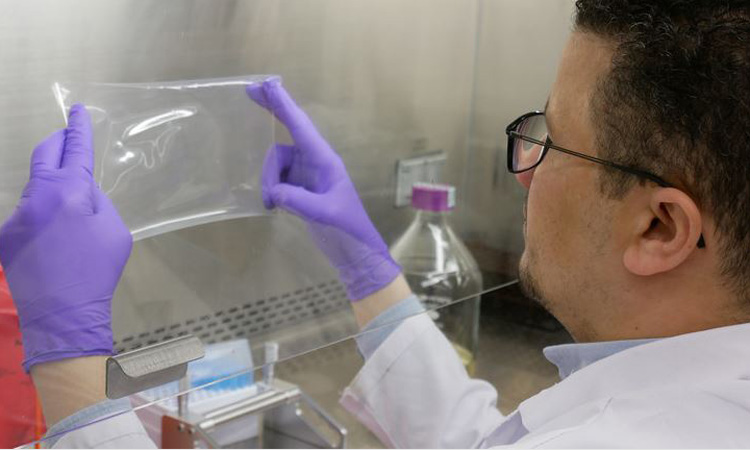A novel antimicrobial film that could be used to help reduce the risk of Salmonella, Listeria and pathogenic E. coli in food products was developed at Penn State University. The composite film was created by the bonding of an antimicrobial layer to conventional, clear polyethylene plastic typically used to vacuum-package foods such as meat and fish. The antimicrobial layer of the film is comprised of a pullulan-based biopolymer produced from starch syrup, infused with Lauric arginate. The pullulan film slows the release of the antimicrobial, disbursing it at a predictable rate to provide continuous bacteria-killing activity. Shiga toxin-producing E. coli, Salmonella spp., Listeria monocytogenes, and Staphylococcus aureus were experimentally inoculated onto raw beef, raw chicken breast, and ready-to-eat turkey breast, vacuum packaged with the composite antimicrobial film, sealed and placed into refrigerated storage for up to 28 days. The composite film significantly reduced foodborne pathogens on the experimentally inoculated surfaces during refrigerated storage. @ https://www.newfoodmagazine.com/news/104055/novel-composite-antimicrobial-film-could-help-combat-foodborne-illnesses/?utm_source=Email+marketing&utm_medium=email&utm_campaign=NF+-+Newsletter+5+-+Neogen+-+30.01.20&utm_term=eAlert%3a+US+meat+recalls+increased+by+65+percent+since+2013+Decaf+coffee+investigation+finds+methylene+chloride+in+several+products+Food+Integrity+2020++more...&utm_content=http%3a%2f%2femails.newfoodmagazine.com%2frussellpublishinglz%2f&gator_td=PAAJEGS0V9sW0tiXQDxn%2fpF4%2fckhQKk4FxUXvS91P%2fnrFZH4ughufJUpYUBb9f9qDiQ5XtMsIZX1F0MMubBaGKbnwjwAMYsKk4W60jGrJMKQwOl6QFVU6pr3iRL76gAF3w%2b921%2f6Hetn4tCRudpyM6TLhG0EP8uUeGMxuYJoC7uwx6jFE30sSaZzMdH6Rb4c1rKs8Ytm0D78t5FJkKh5pw%3d%3d
A Novel composite antimicrobial film could help fight food pathogens
Novel composite antimicrobial film could help combat foodborne illnesses
A novel composite film could help to decrease foodborne illness outbreaks, according to researchers in Penn State’s College of Agricultural Sciences.
No comments

